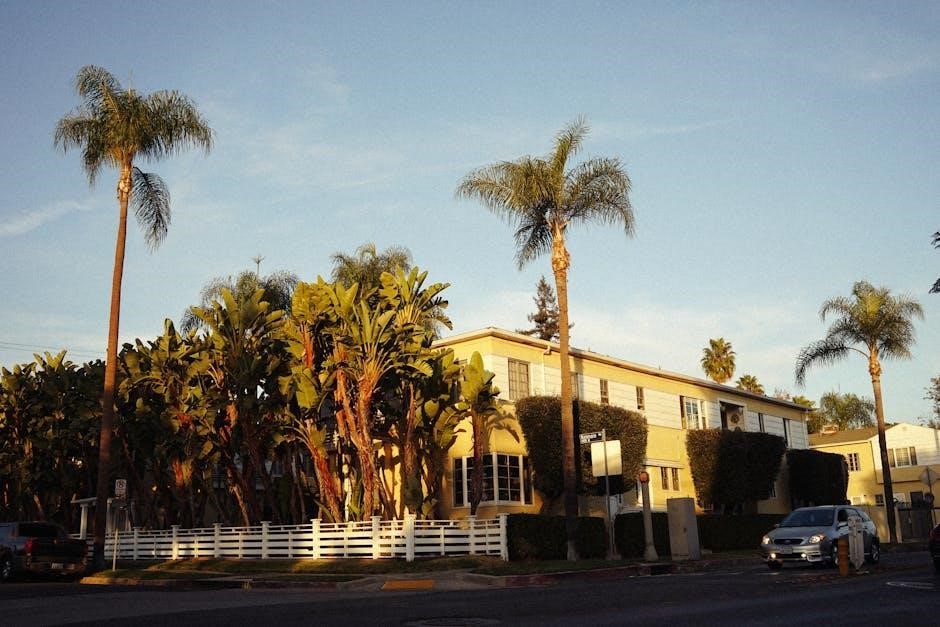Southern California boasts a Mediterranean climate with hot, dry summers and mild, wet winters. USDA hardiness zones range from 8 to 11, ideal for diverse planting options.
1.1 Overview of Southern California’s Mediterranean Climate
Southern California’s Mediterranean climate is characterized by hot, dry summers and mild, wet winters. This unique climate pattern supports a wide variety of plant life, with warm temperatures dominating most of the year. The region experiences minimal rainfall, with most precipitation occurring between December and March. Summer months are typically dry and sunny, with high temperatures often reaching over 90°F. This climate necessitates the use of drought-tolerant plants and water-efficient gardening practices. The mild winters allow for year-round growth of certain species, making Southern California an ideal location for diverse gardening opportunities. Understanding this climate is key to successful planting and maintenance in the region.
1.2 Understanding USDA Hardiness Zones in Southern California
Southern California spans USDA Hardiness Zones 8 to 11, reflecting its diverse microclimates. Zone 8 covers cooler coastal areas, while Zone 11 represents the hottest inland regions. These zones determine which plants can thrive based on average annual extreme temperatures. Gardeners in Zone 8 should focus on plants tolerant of cooler winters, while those in Zone 11 can grow tropical and subtropical species year-round. Understanding these zones helps gardeners select appropriate plants and plan planting schedules effectively. This knowledge is essential for optimizing plant health and ensuring successful growth in Southern California’s varied conditions.
Best Plants for Southern California Gardens

Southern California gardens thrive with drought-tolerant plants like succulents, California poppies, and lavender. These species are well-suited to the region’s Mediterranean climate, ensuring year-round beauty and growth.
2.1 Drought-Tolerant Plants for Water Efficiency
Drought-tolerant plants are ideal for Southern California gardens due to the region’s dry climate. Succulents like aloe vera, agave, and echeveria thrive with minimal watering. California poppies, lavender, and yucca are also excellent choices, requiring little water once established. These plants have adapted to store water or survive prolonged dry periods, making them perfect for water-efficient landscapes. They not only conserve water but also add beauty and resilience to gardens. Incorporating these species ensures vibrant, low-maintenance gardens that align with the region’s environmental conditions. Planting drought-tolerant varieties supports sustainability and reduces the need for frequent irrigation, making them a practical choice for Southern California gardeners. Soil preparation and proper sunlight exposure are key to their success.
2.2 Native Plants Perfect for Southern California Soil
Native plants are perfectly adapted to Southern California’s soil and climate, requiring less water and care. California poppies, purple sage, and coyote mint are excellent choices, attracting pollinators and thriving in local conditions. Toyon and California lilac are ideal for hedges or screens, while matilija poppy and bush sunflower add vibrant colors. These plants support local wildlife and reduce the need for fertilizers, making them eco-friendly. Incorporating natives enhances biodiversity and creates a low-maintenance, resilient garden. They are also more resistant to pests and diseases, ensuring a healthier landscape. Planting native species is a sustainable way to enjoy the region’s natural beauty while conserving water and resources. They truly shine in Southern California’s unique environment, offering both beauty and functionality.
2.3 Edible Plants and Vegetables for Year-Round Harvest
Southern California’s climate allows for year-round harvesting of edible plants. Spring and summer are ideal for tomatoes, peppers, zucchini, and eggplants, while fall and winter favor kale, spinach, and broccoli. Herbs like basil and rosemary thrive in the warm seasons, and citrus trees produce fruit year-round. Drought-tolerant options like succulent purslane and sorrel add unique flavors to dishes. Root vegetables such as carrots and beets also grow well in cooler months. Planting a mix of annuals and perennials ensures a constant supply of fresh produce, leveraging the region’s mild winters and long growing season for a bountiful harvest.
Seasonal Planting Guide
Southern California’s Mediterranean climate supports year-round planting. Spring is ideal for vibrant flowers and vegetables, while summer favors drought-tolerant plants. Fall and winter thrive with cool-season crops, ensuring a continuous harvest cycle;
3.1 Spring Planting: What to Grow in March-May
Spring in Southern California, spanning March to May, is an ideal time to plant a variety of flowers, vegetables, and herbs. The mild weather and ample sunlight make it perfect for vibrant blooms like marigolds, zinnias, and California poppies. For edible gardens, tomatoes, peppers, and cucumbers thrive in the warming temperatures. Herbs such as basil, rosemary, and mint also grow well during this season. Native plants like California sage and lupines are excellent choices, as they attract pollinators and require less water. This period is also great for planting summer bulbs and preparing soil for the upcoming heat. With proper care, spring planting sets the stage for a lush and productive garden.
3.2 Summer Planting: Heat-Tolerant Crops for June-August
Summer in Southern California brings intense heat, making it ideal for planting heat-tolerant crops. Vegetables like tomatoes, peppers, and eggplants thrive in the warm weather. Okra, corn, and squash are also excellent choices for summer gardens. Herbs such as basil and oregano grow well and add fresh flavor to dishes. For colorful blooms, marigolds, zinnias, and sunflowers are perfect. Melons like watermelon and cantaloupe prefer the warm soil and dry conditions. Native wildflowers like California poppies and lupines also bloom vibrantly during this season. Proper soil preparation and consistent irrigation are key to success. Drip irrigation systems and mulch can help conserve water and protect plants from heat stress.
3.3 Fall and Winter Planting: Cool-Season Crops

Fall and winter in Southern California offer ideal conditions for cool-season crops. Vegetables like broccoli, kale, spinach, and Brussels sprouts thrive in the cooler temperatures. Root vegetables such as carrots, beets, and radishes also grow well. Herbs like parsley and cilantro prefer the mild winters. Planting in late summer or early fall allows for a fall harvest, while late winter planting prepares for a spring harvest. The region’s mild winters make it possible to grow multiple crops year-round. Proper soil preparation and care, including fertilization and mulching, ensure healthy growth. These crops are perfect for extending the gardening season and enjoying fresh produce during cooler months.

Soil Preparation and Care
Preparing soil is crucial for Southern California gardens. Test pH levels, add compost, and fertilize accordingly. Mulching retains moisture and suppresses weeds, ensuring healthy plant growth year-round.
4.1 Tips for Improving Soil Quality in Southern California
Improving soil quality in Southern California requires addressing the region’s sandy, nutrient-poor soil. Start by testing your soil pH to determine its acidity or alkalinity. Add compost or well-rotted manure to enhance organic matter, improving drainage and water retention. Mulching helps suppress weeds and retain moisture, while also breaking down into nutrient-rich humus. Incorporate native plants, as they are adapted to local soil conditions. Avoid over-tilling, as it can damage soil structure. Use balanced fertilizers, focusing on nitrogen, phosphorus, and potassium. Consider drip irrigation to avoid leaching nutrients. Finally, plant drought-tolerant species to reduce water demand and protect soil health.

4.2 Fertilization and Mulching Strategies
Fertilization and mulching are crucial for Southern California gardens. Use slow-release fertilizers during the growing season to provide steady nutrient supply. Opt for organic options like compost tea or worm castings to enrich soil naturally. Mulching helps retain moisture, suppress weeds, and regulate soil temperature. Apply a 2-3 inch layer of organic mulch like wood chips or bark. Replenish annually to maintain benefits. Avoid over-fertilizing to prevent nutrient runoff. Combine mulching with drip irrigation for efficient water and nutrient delivery. These strategies promote healthy plant growth and sustainable gardening practices in Southern California’s challenging climate. Regular monitoring ensures optimal soil health and plant productivity.

Water Conservation and Irrigation
Southern California gardens benefit from efficient irrigation techniques like drip systems and rainwater harvesting. These methods conserve water while ensuring plants receive adequate moisture, promoting sustainability.

5.1 Efficient Irrigation Techniques for Southern California Gardens

Efficient irrigation is crucial in Southern California’s dry climate. Drip irrigation delivers water directly to roots, reducing evaporation and runoff. Install timers and moisture sensors to optimize water use. Consider using soaker hoses for flower beds and vegetable gardens, as they provide consistent moisture. Rain barrels collect and store rainwater for non-potable uses, lowering water bills; Smart controllers adjust watering schedules based on weather, ensuring plants receive the right amount of moisture. Mulching around plants retains soil moisture and suppresses weeds, further conserving water. These techniques help maintain healthy gardens while promoting water conservation and sustainability in the region.
5.2 Rainwater Harvesting and Drip Irrigation Systems
Rainwater harvesting is a sustainable way to collect and store rain for irrigation, reducing reliance on municipal water. Install barrels or tanks with filters to catch and store rainwater. Drip irrigation systems deliver water slowly and directly to plant roots, minimizing waste. Combine these methods for optimal water conservation. Use smart controllers to automate drip irrigation, ensuring plants receive precise moisture levels. Rainwater harvesting reduces runoff and lowers water bills, while drip systems promote healthy plant growth. These eco-friendly practices are ideal for Southern California’s climate, helping gardeners conserve water while maintaining thriving landscapes. They also support drought-tolerant plants, aligning with the region’s water-saving goals.